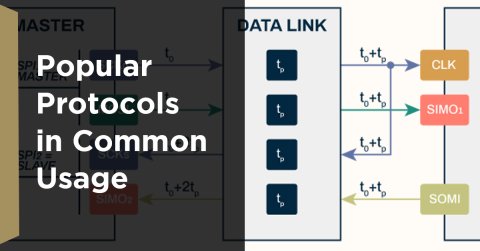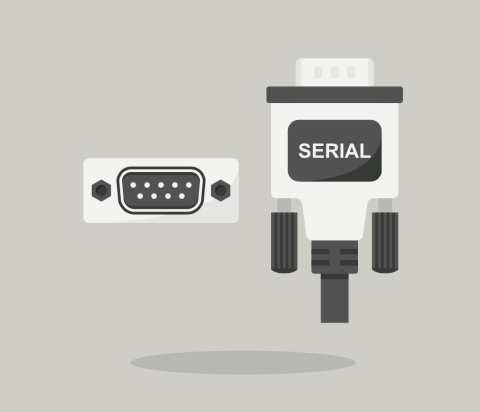Understanding Signal Reflections for High-Speed Design

Introduction
Signal reflections and the engineering related to impedance matching are one of the basic topics related to design of high-speed digital systems. In the case of digital system with a high bit rate, in which information about the state of bits "0" and "1" is sent in the form of a square wave signal, it is assumed that the rise (or fall) time of the rising and falling edges are negligible in relation to the binary signal frequency. In practice, a digital signal never rises and falls infinitely fast. The rise (and fall) time is determined by the parameters of the signal path that includes the transmitter, receiver parameters, and the physical characteristics of the transmission line.
In the case of high-speed systems, rise and fall time may be as short as 1ns or below. The binary signal frequency in digital systems can reach several GHz and to maintain a relatively rectangular shape, the rising and falling edges should be a fraction of the bit duration.
The speed of electromagnetic wave propagation (propagation of voltage and current in the transmission line) depends on several factors, including the type of transmission line and the type of substrate. For example: for FR4 substrate and microstrip transmission lines, the propagation speed is approximately 160Mm/s (megameters per second) or 525Mft/s (mega feet per second). If the edge rise (or fall) time is e.g. 200ps, then the rising (or falling) edge will travel along the transmission line 32mm or 1.25inch during rise or fall time.
Retaining signal shape depends on whether the transmission line along the PCB, over a length comparable to the distance traveled by the rising (or falling) edge, maintains impedance continuity and proper termination on the receiver side. In the case of very short connections or slow rising (falling) time of the digital signal, the phenomena of reflections, as described here, may not be observable and may be skipped. As a rule of thumb, it can be assumed that if the distance traveled by the signal edge (i.e. the product of the propagation time and the propagation speed) is more than 10% of the transmission length, care should be taken to properly match the outputs, inputs and transmission line - this procedure is called impedance matching and includes the design of the traces on the PCB as well as matching networks, composed with resistors.
Impedance matching and resistive matching
The relationship that determines the impedance matching condition is well known. If the output impedance of the TX is a complex conjugate of the impedance of the receiver and the path connecting the transmitter and receiver has the resistance the same as the real part of the transmitter and receiver, then the signal path is matched. In practical cases of digital systems, matching is not performed by implementing a complex conjugate impedance matching network for the transmitter or receiver path (this will require inductors and capacitors added to the signal lines to cancel any imaginary impedance components. Also this type of matching is usually narrow band so it has no practical application in digital systems).
A common practice is to match only the resistive part of the transmitting and receiving ICs and make the transmission line characteristic impedance purely resistive. In this case, only resistors are needed to provide required matching, e.g. a series resistor at the driver output is one of the possible solutions to match the transmitter to the transmission line. At the receiver a parallel resistor to ground can be used (or For a differential pair - a resistor between the traces forming the differential pair). Some examples related to receiver termination topologies are shown in figure 1 taken from the Signal Integrity tool available in Altium Designer.

Figure 1: Termination topologies available in Altium Designer Signal Integrity tool
Examples of signal reflections in the digital system
This chapter discusses signal matching examples with reflection waveforms that will be based on the 50Ω system - system common for radio frequency designs, however relationships presented in this section also apply to digital systems that use other impedance profiles as well as for signals transmitted by means of differential pairs - common for high-speed digital systems, e.g. USB3.0 or PCIe. Presented considerations omit the influence of the imaginary part of the impedance of the transmitter, receiver. Transmission line is designed by means of impedance profile (set to 50Ω) defined in Altium Designer. In this case the matching condition takes the form defined by equation 1 in which each resistance has a value of 50Ω.
For simulation purposes the IBIS model of the LMK00334RTVR chip was used. Resistors used for matching components for this chip are close enough to 50Ω - it was proven that the system is well matched by means of simulation when 50Ω resistances were used. Note that the LMK00334RTVR may require different values for terminating inputs and outputs.
Ro=Ri=Rt=50Ω (eq. 1)
Where:
- Ro - output resistance of the transmitter,
- Ri - input resistance of the receiver,
- Rt - characteristic impedance of the transmission line.
Matched system case, single pulse excitation
In the case of proper matching design, the resistances in the matching network are defined by an equation 1. The diagram of such a system is shown in figure 2 and the simulation results are presented in figure 3. There is no signal reflection in the system along the transmission line. The signal is sent from pin U29 of U1, travels through series matching resistor (R5) and is completely absorbed by the load resistor (R4) at the other end of the line. Total energy was absorbed by R4 and therefore no reflection occurred - only the source pulse is visible.

Figure 2: Schematic of the circuit setup used for simulation

Figure 3: Single pulse simulation in fully matched circuit
Reflections in the system for a single pulse excitation. In-phase reflection case
If resistances given by equation 1 are not the same, reflections occur in the system. Signal reflection example is presented in figure 4, where the receiver shunt resistance was increased from 50Ω to 10kΩ (see figure 2, resistor R4) and the transmitter resistance (R5) was reduced to 1Ω. In this case, the pulse sent by the transmitter was not absorbed by R4 at the receiver side. The signal was reflected and returned to the transmitter input after about 1.6ns. Knowing the propagation time and speed, one can calculate the distance from the signal transmitter to a place where the impedance mismatch occurred, keeping in mind that the pulse travels this distance twice. Altium Designer provides the propagation time value for a given net - see figure 5. The propagation time for this particular net was calculated by Altium Designer and it is equal to 807ps. For a round trip this is approximately 1.6ns.

Figure 4: Single pulse reflection case

Figure 5: Propagation delay of the transmission line, calculated by Altium Designer
Reflections in the system for a single pulse excitation. Out of phase reflection case
In this case the matching network resistors were set as follows: Ro=R5=50Ω. Also, the Ri=R4 was set to 100mΩ (can be considered as a short circuit compared to 50Ω). If the transmission line at the other end is terminated with a resistance that is lower than the resistance of the source and the transmission line, then the signal is reflected 180 degrees out of phase. This reflection results in a negative voltage in the transmission line - see figure 6. This negative voltage may lead to conduction of the protection diodes of the integrated circuit pins or even damage the chip.

Figure 6: Negative and positive reflections in the transmission line
Reflections caused by a non-uniform impedance profile of the transmission line, single pulse excitation
In this case, the transmitter and receiver are matched (Ro=Ri=50Ω=R4=R5), while the transmission line is designed to have a non-uniform characteristic impedance along its length - see figure 7. This results in reflections caused by the non-uniform impedance along the line. Simulation result for this case, done in Altium Designers SI tool, is shown in figure 8. In this case a series of signal reflections occurs along the line. This shows that the impedance of the transmission path should be designed to be uniform along its length. Such design improves signal integrity of the system.
Unwanted change in the characteristic impedance along the transmission line may have different origins, for example: it may be related to a change in its width (as shown in figure 7). Also, other factors play a significant role in creating non uniform impedance e.g. loss of the reference plane, set of vias along the line, copper fields located close to the transmission line and more.

Figure 7: Non uniform impedance along transmission line

Figure 8: Effects of non uniform transmission line
Reflections in the unmatched transmission line with square wave excitation
Figure 9 presents the case for the signal mismatch of the receiver, transmitter and transmission line (including its discontinuity). In this case, the transmitter feeds the line with a 1GHz square wave signal to mimic digital communication in the system. This signal becomes completely distorted by a series of reflections in such a mismatched system. Transmission line voltage oscillates around 1.5V, also exceeding the initial state (1.85V) by almost 400mV. In this case, communication in the system will be interrupted. There are also high frequency components in the line exceeding 1GHz that may be a source of interference and problems with EMI. Transmitter constantly excites the line, providing energy to maintains the so-called standing wave in the transmission line, completely distorting the original signal.

Figure 9: Unmatched system with continuous excitation in the transmission line
Conclusions
Signal reflections are the result of impedance mismatch in the signal chain, that includes the transmitter, receiver and the transmission line resistances or impedances. Reflections are also related to incorrect design of the transmission line used for digital (high-speed) or analog signals, such as the carrier wave of a radio system. The occurrence of reflections deteriorates the integrity of signals and may lead to an increased error rate in the system as well as increased electromagnetic emissions.
Simulation results presented in the article were carried out in the Altium Designer Signal Integrity tool. Altium Designer supports designers of high speed systems in implementing the correct schematic and PCB design by providing tools for simulating high frequency circuits and phenomena, such as signal reflections discussed in the article.
For maximum impact, pair those insights with Altium Agile Teams: using this solution, each SI issue becomes a tracked task, a documented fix, and part of your team’s shared workflow across ECAD, MCAD, and system engineering. This ensures consistent quality, repeatable processes, and faster delivery across your projects.
Start with Agile Teams Eval Flow here: Get Started











